Effects of Reconstruction Planning on the Utility of Social Capital in Minamisanriku, Miyagi after the 2011 Great East Japan Earthquake
Abstract
:1. Introduction
1.1. The Uses, Roles, and Functions of Social Capital
1.2. Forms of Social Capital—Bonding, Bridging, and Linking
1.3. Application and Outcomes of Social Capital in Disaster Studies in Japan
1.3.1. Social Capital as an Economic Driver
1.3.2. Social Capital as a Recovery Driver
1.3.3. Social Capital as a Collective Action Driver
1.3.4. Opposing Arguments to Social Capital Disaster Studies
1.4. Social Capital Considerations for This Study
2. Methodology
Community-Based Participatory Research
3. Materials and Methods
3.1. Research Objective and Design
3.1.1. Social Capital Mapping
3.1.2. Interviews
3.1.3. Participant Observation
3.1.4. Secondary Data
3.2. Analytical Methods
4. Minamisanriku—Reconstruction and Social Capital
4.1. Reconstruction Planning and Development
4.2. Changes to Community
4.3. Changes to Population and Households
4.4. Economic Changes
4.5. Implications for This Study
5. Results
5.1. Demographic Characteristics of Mapping Participants
5.2. Cross-Tabulation of Participant District by Relation’s Gender, Tie Strength, Relationship, and Social Capital
5.3. Directional Relationship between Participant District, Relation District, and Linking Capital
5.4. Interviews on Decision Making and Town Development
6. Discussion
6.1. Decision Making and Influence—One’s Place and One’s Role
6.2. Decision Making and Influence—Navigating Power and Accessing Information
- Ward:
- When I’ve spoken with other residents, many complain that there is not enough resident-focused projects, such as building public baths, parks, and other amenities for them to enjoy. Why do you think the local government hasn’t created more resident-centered projects?
- Abe:
- (head nodding) Yes, that was an issue back in (pause) 2014. I can’t remember the name of it, but a lot of those things are supposed to be built now. I think most residents don’t know that the local government shares decision-making with the tourism association, so (pauses)…well, there was just more concern for recovery of the business district I think… both groups have equal input on town development projects because most funding isn’t controlled by the local government but by the tourism association… Most subsidies come to us as economic grants, but I believe the majority are designated for tourism development.
- Ward:
- So, what I’m trying to understand, is that residents don’t understand why the town office supports other projects, but you mean that residents aren’t aware of the tourism association’s role on deciding projects? Sorry, I am just trying to clarify.
- Abe:
- Yes, that is correct.
6.3. Decision Making and Collaboration—From within Districts, Not between Districts
6.4. Town Development—Responsibility, Social Infrastructure, and Economic Infrastructure
7. Conclusions
7.1. Reconstruction Influence on the Utility of Social Capital
7.2. Social Capital as an Asset to Driving Economic Growth, Recovery, Collaboration, and Decision Making
7.3. The Role of Linking Capital
7.4. Future Social Capital Disaster Studies and Reconstruction Planning in Japan
Funding
Institutional Review Board Statement
Informed Consent Statement
Data Availability Statement
Acknowledgments
Conflicts of Interest
Appendix A
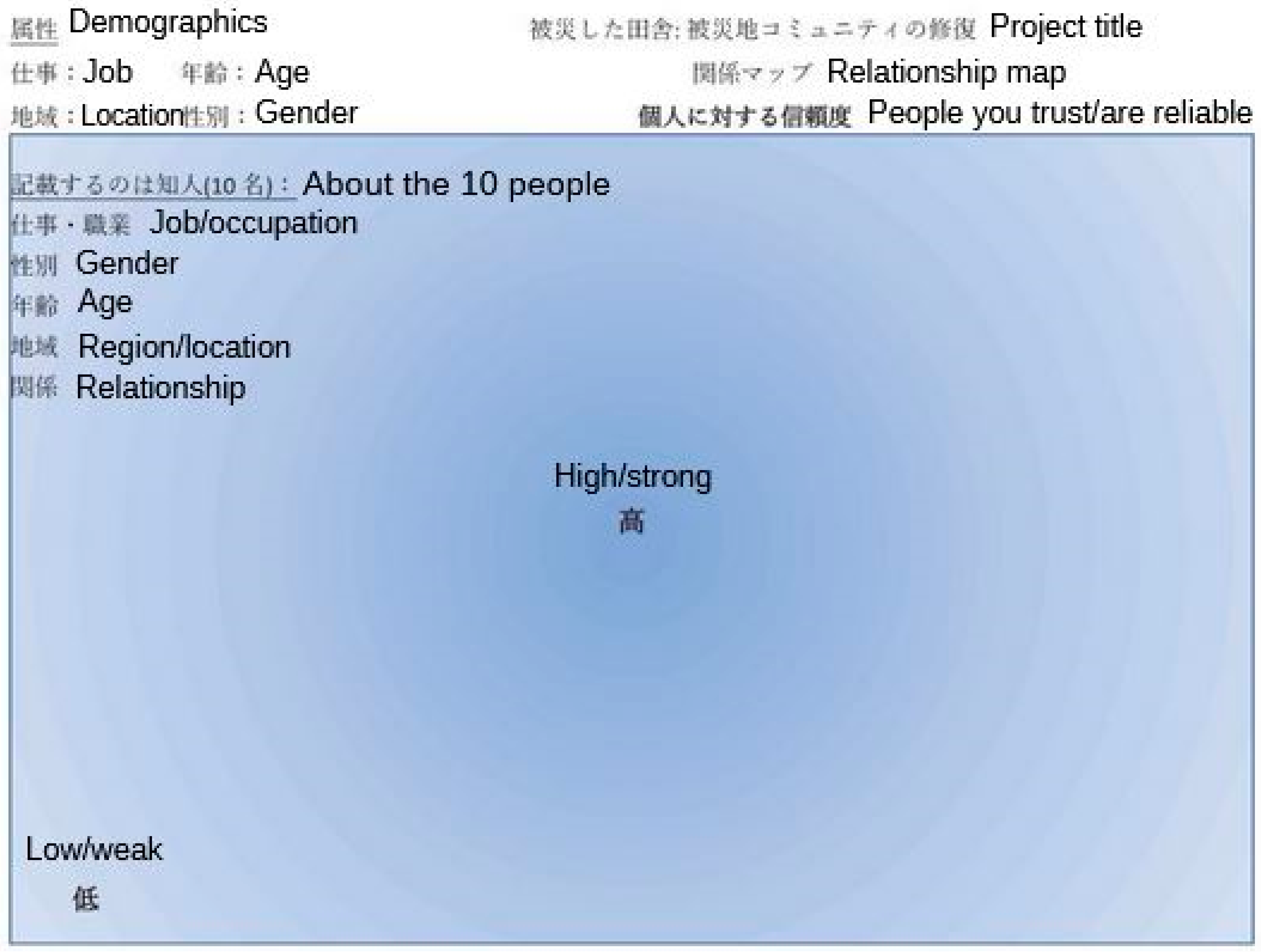
Appendix B
Interview Questions and Protocol
- Can you influence decisions that affect your life?
- Are you satisfied with the amount of influence you have over decisions that affect your life?
- Can you influence decisions that affect your neighborhood?
- Are you satisfied with the amount of influence you have over decisions that affect your neighborhood?
- By working together with others, can you influence decisions that affect your neighborhood?
- Does your neighborhood have influence over things that affects your life?
- Can you influence decisions that affect your area (Shizugawa, Togura, Utatsu, Iriya)?
- Are you satisfied with the amount of influence you have over decisions that affect your area (Shizugawa, Togura, Utatsu, Iriya)?
- Can you influence decisions that affect Minamisanriku?
- Are you satisfied with the amount of influence you have over decisions that affect Minamisanriku?
- By working together, can people in your neighborhood influence decisions that affect Minamisanriku?
- Do people in your neighborhood have connections to people who can influence what happens within Minamisanriku?
- What sort of new programs do you want in Minamisanriku? Why?
- What do you think the current needs of Minamisanriku are? Are these different from what your neighborhood/district needs or are they the same?
- What needs would you like the local government to address? Have they addressed these in the past?
References
- Aldrich, Daniel P. 2010. Fixing recovery, social capital in post-crisis resilience. Journal of Homeland Security 6: 1–10. [Google Scholar]
- Aldrich, Daniel P. 2011. The Power of People: Social capital’s Role in Recovery from the 1995 Kobe Earthquake. Natural Hazards 56: 595–611. [Google Scholar] [CrossRef]
- Aldrich, Daniel P. 2012a. Building Resilience: Social Capital in Post-Disaster Recovery. Chicago: The University of Chicago Press. [Google Scholar]
- Aldrich, Daniel P. 2012b. Social, Not Physical, Infrastructure: The Critical Role of Civil Society after the 1923 Tokyo Earthquake. Disasters 36: 398–419. [Google Scholar] [CrossRef] [PubMed]
- Aldrich, Daniel P., and Michelle A. Meyer. 2015. Social Capital and Community Resilience. The American Behavioral Scientist 59: 254–69. [Google Scholar] [CrossRef]
- Aldrich, Daniel P., and Yoshikuni Ono. 2016. Local politicians as linking social capital: An empirical test of political behavior after Japan’s 3/11 disasters. Natural Hazards 84: 1637–59. [Google Scholar] [CrossRef]
- Arias, Valera. 2015. Community knowledge sharing and co-production of water services: Two cases of community aqueduct associations in Colombia. Water Alternatives 8: 77–98. [Google Scholar]
- Blackwell, Angela, and Raymond Colmenar. 2000. Community building: From local wisdom to Public Policy. Public Health Reports 115: 161–66. [Google Scholar] [CrossRef]
- Bourdieu, Pierre. 1986. Forms of capital. In Handbook of Theory and Research for the Sociology of Education. Edited by John Richardson. Westport: Greenwood Press, pp. 241–60. [Google Scholar]
- Briggs, Xavier. 2003. Social capital, types of. In The Encyclopedia of Community: From the Village to the Virtual World. Edited by Levinson David and Karen Christensen. Thousand Oaks: Sage, pp. 1277–83. [Google Scholar]
- Campbell, Christopher. 2000. Social structure, space and sentiment: Searching for common ground in sociological conceptions of community. In Research in Community Sociology. Edited by Chekki Dan. London: JAI Press, pp. 21–57. [Google Scholar]
- Cheek, Wesley. 2020. The Paradox of Community Involvement: Rebuilding Minamisanriku. Disaster Prevention and Management Ahead-of-print. , 893–907. [Google Scholar] [CrossRef]
- DiIulio, John J. 1996. Help Wanted: Economists, Crime and Public Policy. The Journal of Economic Perspectives 10: 3–24. [Google Scholar] [CrossRef]
- Esri. 2020. “Cho Cho Moku Boundaries” (Basemap). Scale not Given. “Map of Minamisanriku by District.”. Available online: https://services.arcgis.com/P3ePLMYs2RVChkJx/arcgis/rest/services/JPN_Boundaries_2020/FeatureServer (accessed on 20 June 2021).
- Flora, Cornelia B., Jan L. Flora, and Stephen P. Gasteyer. 2016. Rural Communities: Legacy and Change. Boulder: Westview Press. [Google Scholar]
- Fraser, Timothy, Daniel Aldrich, Andrew Small, and Andrew Littlejohn. 2021. In the Hands of a Few: Disaster Recovery Committee Networks. Journal of Environmental Management 280: 111643. [Google Scholar] [CrossRef]
- Fukao, Masataka. 2019. Community Foundations and Social Investments in Japan. In Depopulation, Deindustrialisation and Disasters: Building Sustainable Communities in Japan. Edited by Shiraishi Katsutaka and Nobutaka Matoba. Cham: Palgrave Macmillan, pp. 335–51. [Google Scholar] [CrossRef]
- Fukuyama, Francis. 2001. Social Capital, Civil Society and Development. Third World Quarterly 22: 7–20. [Google Scholar] [CrossRef]
- Gill, Tom. 2014. Review of the book Building resilience: Social capital in post-disaster recovery by Aldrich, Daniel. Social Science Japan Journal 17: 118–22. [Google Scholar] [CrossRef] [Green Version]
- Gold, Steven J., and Ivan Light. 2000. Ethnic Economies and Social Policy. In Research in Social Movements, Conflicts and Change. Edited by Patrick G. Coy. Ohio: Emerald Group Publishing Limited, vol. 22, pp. 165–91. [Google Scholar] [CrossRef]
- Goulding, Christina, Mihaela Kelemen, and Toru Kiyomiya. 2018. Community based response to the Japanese tsunami: A bottom-up approach. European Journal of Operational Research 268: 887–903. [Google Scholar] [CrossRef]
- Hawkins, Robert L., and Katherine Maurer. 2010. Bonding, Bridging, and Linking: How Social Capital Operated in New Orleans Following Hurricane Katrina. British Journal of Social Work 40: 1777–93. [Google Scholar] [CrossRef] [Green Version]
- Hurlbert, Jeanne S., John J. Beggs, and Valerie A. Haines. 2001. Social Networks and Social Capital in Extreme Environments. In Social Capital: Theory and Research. Edited by Lin Nan, Karen S. Cook and Ronald S. Burt. New York: Aldine de Gruyter, pp. 209–31. [Google Scholar]
- Inaba, Youji. 2011. How to Develop Social Capital—A Perspective from Policy Making (Shakai Kankei Shihon wo Dou Jousei Surunoka—Seusaku Taisyo to Shiteno Shiten). Tokyo: DIO Research Institute for Advancement of Living Standards. [Google Scholar]
- Israel, Barbara A., Eugenia Eng, Edith A. Parker, and Amy J. Schulz. 2012. Methods for Community-Based Participatory Research for Health, 2nd ed. Somerset: Jossey-Bass. [Google Scholar]
- Ivankova, Nataliya V. 2015. Mixed Methods Applications in Action Research: From Methods to Community Action. Thousand Oaks: SAGE Publications. [Google Scholar]
- James, Helen, and Douglas Paton. 2016. The Consequences of Disasters: Demographic, Planning, and Policy Implications. Springfield: Charles C. Thomas, Publisher, Ltd. [Google Scholar]
- Kaneko, Yuka. 2017. Reconstruction of communities: Lessons from Hanshin-Awaji Earthquake and East Japan Earthquake. In Community-Based Reconstruction of Society. Edited by Hokugo Akihiko and Yuka Kaneko. Kobe University Social Science Research Series; Singapore: Springer Nature, pp. 13–17. [Google Scholar] [CrossRef]
- Knack, Stephen, and Philip Keefer. 1997. Does social capital have an economic payoff? A cross country investigation. The Quarterly Journal of Economics 112: 1251–88. [Google Scholar] [CrossRef]
- Levine, Sheen S., Evan P. Apfelbaum, Mark Bernard, Valerie L. Bartelt, Edward J. Zajac, and David Stark. 2014. Ethnic diversity deflates price bubbles. Proceedings of the National Academy of Sciences of the United States of America 111: 18524–29. [Google Scholar] [CrossRef] [Green Version]
- Littlejohn, Andrew. 2017. After the Flood: The Politics of Reconstruction in Post-3.11 Tohoku. Ph.D. thesis, Harvard University, Cambridge, MA, USA. [Google Scholar]
- Marín, Andrés, Örjan Bodin, Stefan Gelcich, and Beatrice Crona. 2015. Social capital in post-disaster recovery trajectories: Insights from a longitudinal study of tsunami-impacted small-scale fisher organizations in Chile. Global Environmental Change 35: 450–62. [Google Scholar] [CrossRef] [Green Version]
- Mathbor, Golam M. 2007. Enhancement of community preparedness for natural disasters the role of social work in building social capital for sustainable disaster relief and management. International Social Work 50: 357–69. [Google Scholar] [CrossRef]
- Mertens, Donna M. 2013. Emerging advances in mixed methods: Addressing social justice. Journal of Mixed Methods Research 7: 215–18. [Google Scholar] [CrossRef] [Green Version]
- Minamisanriku Town Office. 2010. Town Statistics. Available online: https://www.town.minamisanriku.miyagi.jp/index.cfm/10,793,c,html/793/2098.pdf (accessed on 14 March 2021).
- Minamisanriku Town Office. 2011. Intention Survey. (Results of Intention Survey on “Reconstruction Town Development in Minamisanriku Town”). Available online: https://www.town.minamisanriku.miyagi.jp/index.cfm/6,301,c,html/301/2218.pdf (accessed on 14 March 2021).
- Minamisanriku Town Office. 2012. Minamisanriku Town Earthquake Reconstruction Plan. Available online: https://www.town.minamisanriku.miyagi.jp/index.cfm/6,303,c,html/303/m-f-gaiyo.pdf (accessed on 14 March 2021).
- Minamisanriku Town Office. 2015. Town Statistics. Available online: https://www.town.minamisanriku.miyagi.jp/index.cfm/10,793,c,html/793/20160323-161759.pdf (accessed on 14 March 2021).
- Minamisanriku Town Office. 2017. Minamisanriku Reconstruction Status. (Reconstruction Status after the Great East Japan Eathquake, Minamisaniku Town Conditions). Available online: https://www.town.minamisanriku.miyagi.jp/index.cfm/6,7752,c,html/7752/20150527-191250.pdf (accessed on 14 March 2021).
- Minamisanriku Town Office. 2020. Town Statistics. Available online: https://www.town.minamisanriku.miyagi.jp/index.cfm/10,793,c,html/793/20210414-150022.pdf (accessed on 14 March 2021).
- Ministry of Agriculture, Forestry and Fisheries. 2005. Agriculture and Forestry Census Report. Available online: https://www.maff.go.jp/j/tokei/census/afc/2010/05kekka.html (accessed on 14 March 2021).
- Ministry of Agriculture, Forestry and Fisheries. 2008. Fishery Census. Available online: https://www.maff.go.jp/j/tokei/census/fc/2008/report/index.html (accessed on 14 March 2021).
- Ministry of Agriculture, Forestry and Fisheries. 2010. Agriculture and Forestry Census Report. Available online: https://www.maff.go.jp/j/tokei/census/afc/about/2010.html (accessed on 14 March 2021).
- Ministry of Agriculture, Forestry and Fisheries. 2013. Fishery Census. Available online: https://www.maff.go.jp/j/tokei/census/fc/2013/report/index.html (accessed on 14 March 2021).
- Ministry of Agriculture, Forestry and Fisheries. 2015. Agriculture and Forestry Census Report. Available online: https://www.maff.go.jp/j/tokei/census/afc2015/280624.html (accessed on 14 March 2021).
- Ministry of Agriculture, Forestry and Fisheries. 2018. Fishery Census. Available online: https://www.maff.go.jp/j/tokei/census/fc/2018/200313.html (accessed on 14 March 2021).
- Ministry of Agriculture, Forestry and Fisheries. 2020. Agriculture and Forestry Census Report. Available online: https://www.maff.go.jp/j/tokei/census/afc/2020/index.html (accessed on 14 March 2021).
- Minkler, Meredith, and Nina Wallerstein. 2005. Improving health through community organization and community building: A health education perspective. In Community Organizing and Community Building for Health, 2nd ed. Edited by Minkler Meredith. New Brunswick: Rutgers University Press, pp. 26–50. [Google Scholar]
- Norris, Fran H., Susan P. Stevens, Betty Pfefferbaum, Karen F. Wyche, and Rose L. Pfefferbaum. 2008. Community resilience as a metaphor, theory, set of capacities, and strategy for disaster readiness. American Journal of Community Psychology 41: 127–50. [Google Scholar] [CrossRef]
- Ota, Naofumi. 2019. The Development of Disaster Management Laws and Systems after the Great East Japan Earthquake, and Local Resilience. In Depopulation, Deindustrialisation and Disasters: Building Sustainable Communities in Japan. Edited by Shiraishi Katsutaka and Nobutaka Matoba. Cham: Palgrave Macmillan, pp. 293–313. [Google Scholar] [CrossRef]
- Pham, Theresa Thao. 2016. Engagement in knowledge production, authentication, and empowerment: A community-based participatory research project with Moroccan immigrants in Spain. International Social Work 59: 368–80. [Google Scholar] [CrossRef]
- Pigg, Kenneth, Stephen Gasteyer, Kenneth Martin, Godwin Apaliyah, and Kari Keating. 2015. Community Effects of Leadership Development Education: Citizen Empowerment for Civic Engagement. Morgantown: West Virginia University Press. [Google Scholar]
- Portes, Alejandro, and Patricia Landolt. 2000. Social Capital: Promise and Pitfalls of Its Role in Development. Social Capital: Promise and Pitfalls of Its Role in Development. Journal of Latin American Studies 32: 529–47. Available online: http://www.jstor.org/stable/158574 (accessed on 20 June 2021). [CrossRef] [Green Version]
- Portes, Alejandro. 2014. Downsides of social capital. Proceedings of the National Academy of Sciences of the United States of America 111: 18407–8. [Google Scholar] [CrossRef] [Green Version]
- Putnam, Robert, Ivan Light, Xavier de Souza Briggs, William M. Rohe, Avis C. Vidal, Judy Hutchinson, Jennifer Gress, and Michael Woolcock. 2004. Using Social Capital to Help Integrate Planning Theory, Research, and Practice: Preface. Journal of the American Planning Association 70: 142–92. [Google Scholar] [CrossRef]
- Putnam, Robert. 2000. Bowling Alone: The Collapse and Revival of American Community. New York: Simon & Schuster. [Google Scholar]
- Rosengren, Åsa, Ann-Marie Lindqvist, and Ilse Julkunen. 2014. Towards an inclusive knowledge base for community-based research and sustainable knowledge production. Nordic Social Work Research 4: 86–101. [Google Scholar] [CrossRef]
- Sadri, Arif Mohaimin, Satish V. Ukkusuri, Seungyoon Lee, Rosalee Clawson, Daniel Aldrich, Megan Sapp Nelson, Justin Seipel, and Daniel Kelly. 2018. The role of social capital, personal networks, and emergency responders in post-disaster recovery and resilience: A study of rural communities in Indiana. Natural Hazards 90: 1377–406. [Google Scholar] [CrossRef]
- Sasaki, Yuri, Jun Aida, and Hiroko Miura. 2020. Social capital in disaster-affected areas. Journal of the National Institute of Public Health 69: 25–32. [Google Scholar] [CrossRef]
- Schellong, Alexander R. M. 2008. Government 2.0: An Exploratory Study of Social Networking Services in Japanese Local Government. Transforming Government 2: 225–42. [Google Scholar] [CrossRef]
- Sekine, Kae, and Alessandro Bonanno. 2016. The Contradictions of Neoliberal Agri-Food, Corporations, Resistance, and Disasters in Japan. Morgantown: West Virginia University Press. [Google Scholar]
- Shaw, Rajib. 2014. Community Practices for Disaster Risk Reduction in Japan. Tokyo: Springer Japan. [Google Scholar]
- Shimada, Go. 2015. The role of social capital after disasters: An empirical study of Japan based on Time-Series-Cross-Section (TSCS) data from 1981 to 2012. International Journal of Disaster Risk Reduction 14: 388–94. [Google Scholar] [CrossRef]
- Shimada, Go. 2017. A quantitative study of social capital in the tertiary sector of Kobe—Has social capital promoted economic reconstruction since the great hanshin awaji earthquake? International Journal of Disaster Risk Reduction 22: 494–502. [Google Scholar] [CrossRef] [Green Version]
- Shinoyama, Kenji. 2013. Disaster management and risk management, and administrative law. (Bousai Saigai Risk Kanri to Gyoseihougaku. Ho no Kagaku 44: 29–38. (In Japanese). [Google Scholar]
- Shiraishi, Katsutaka, and Nobutaka Matoba. 2019. Depopulation, Deindustrialisation and Disasters: Building Sustainable Communities in Japan. Cham: Palgrave Macmillan. [Google Scholar] [CrossRef]
- Szreter, Simon, and Michael Woolcock. 2004. Health by Association? Social Capital, Social Theory and the Political Economy of Public Health. International Journal of Epidemiology 33: 650–67. [Google Scholar] [CrossRef]
- Tierney, Kathleen. 2019. Disasters a Sociological Approach. Cambridge and Medford: Polity Press. [Google Scholar]
- Todo, Yasuyuki, Kentaro Nakajima, and Petr Matous. 2013. How do Supply Chain Networks Affect the Resilience of Firms to Natural Disasters? Evidence from the Great East Japan Earthquake, RIETI Policy Discussion Paper Series. Journal of Regional Science 55: 209–29. [Google Scholar] [CrossRef] [Green Version]
- Torsvik, Gaute. 2000. Social Capital and Economic Development: A Plea for the Mechanisms. Rationality and Society 12: 451–76. [Google Scholar] [CrossRef]
- Waldinger, Rodger. 1995. The ‘other side’ of embeddedness: A case study of the interplay between economy and ethnicity. Ethnicity and Racial Studies 18: 555–80. [Google Scholar] [CrossRef]
- Ward, Kayleigh. 2018. Beyond Recovery: Rural Tohoku Local Politics, Governance, and the Erosion of Social Capital during Reconstruction. Master’s thesis, Michigan State University, Ann Arbor, MI, USA. [Google Scholar]
- Woolcock, Michael. 2001. The place of social capital in understanding social and economic outcomes. Canadian Journal of Policy Research 2: 11–17. [Google Scholar]
- Yamamura, Eiji. 2010. Effects of interactions among social capital, income and learning from experiences of natural disasters: A case study from Japan. Regional Studies 44: 1019–32. [Google Scholar] [CrossRef] [Green Version]
- Ye, Maoxin, and Daniel P. Aldrich. 2019. Substitute or complement? How social capital, age and socioeconomic status interacted to impact mortality in Japan’s 3/11 tsunami. SSM-Population Health 7: 100403. [Google Scholar] [CrossRef]
- Yen-Kohl, Ellen, and The Newtown Florist Club Writing Collective. 2016. “We’ve been studied to death, we ain’t gotten anything”: (re)claiming environmental knowledge production through the praxis of writing collectives. Capitalism, Nature, Socialism 27: 52–67. [Google Scholar] [CrossRef]
- Yotsui, Mihoku, Catherine Campbell, and Teruo Honma. 2016. Collective Action by Older People in Natural Disasters: The Great East Japan Earthquake. Ageing and Society 36: 1052–82. [Google Scholar] [CrossRef] [Green Version]
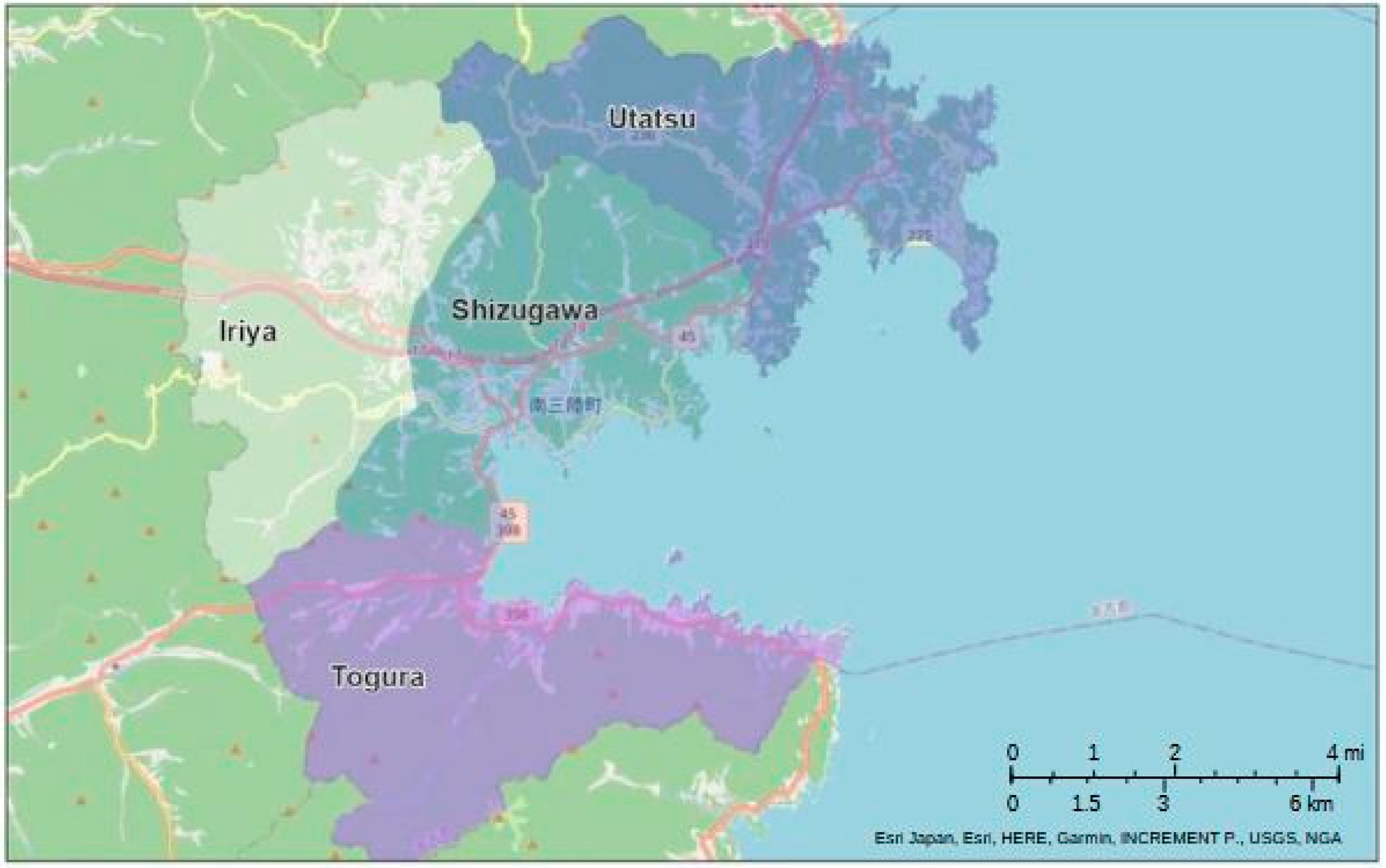
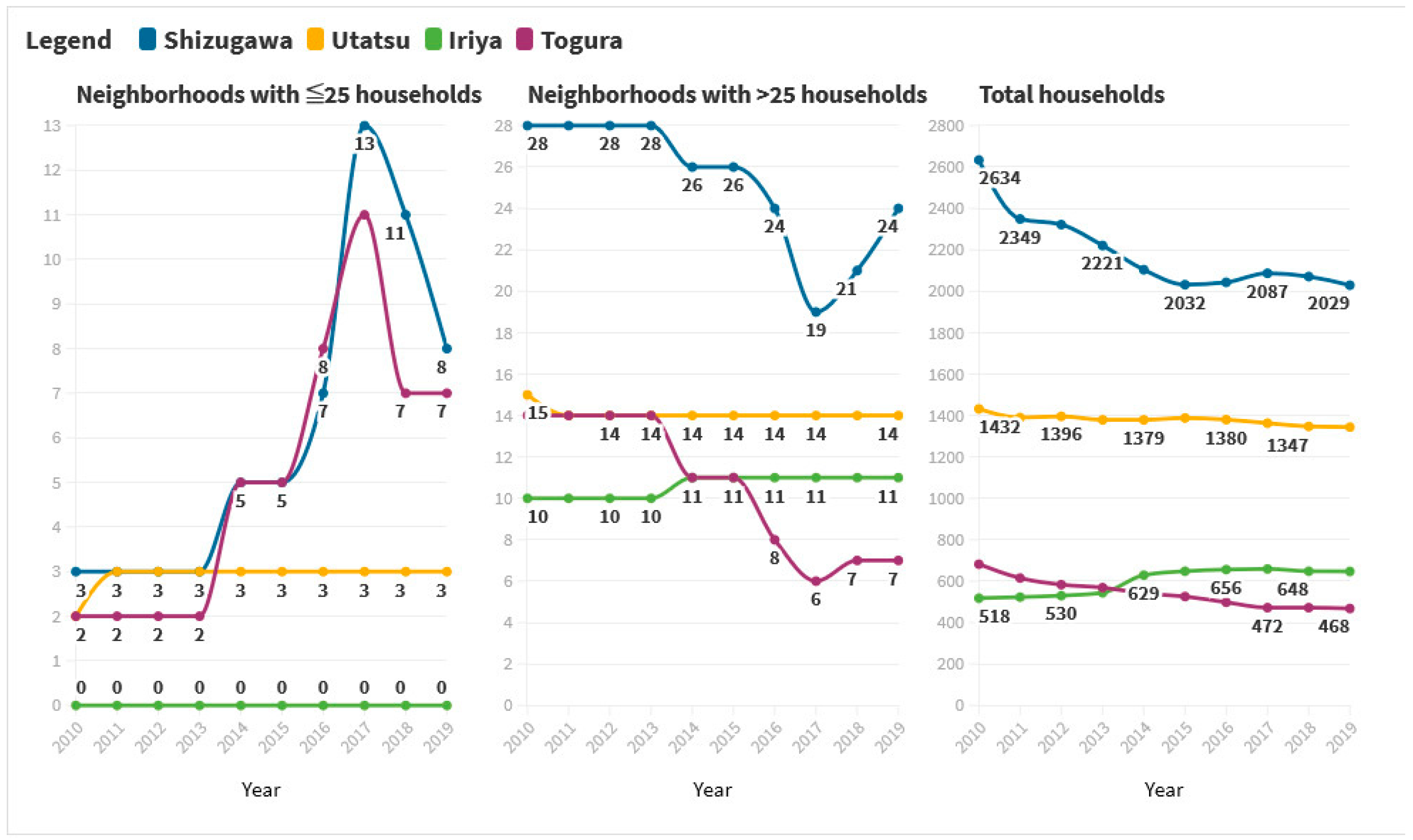
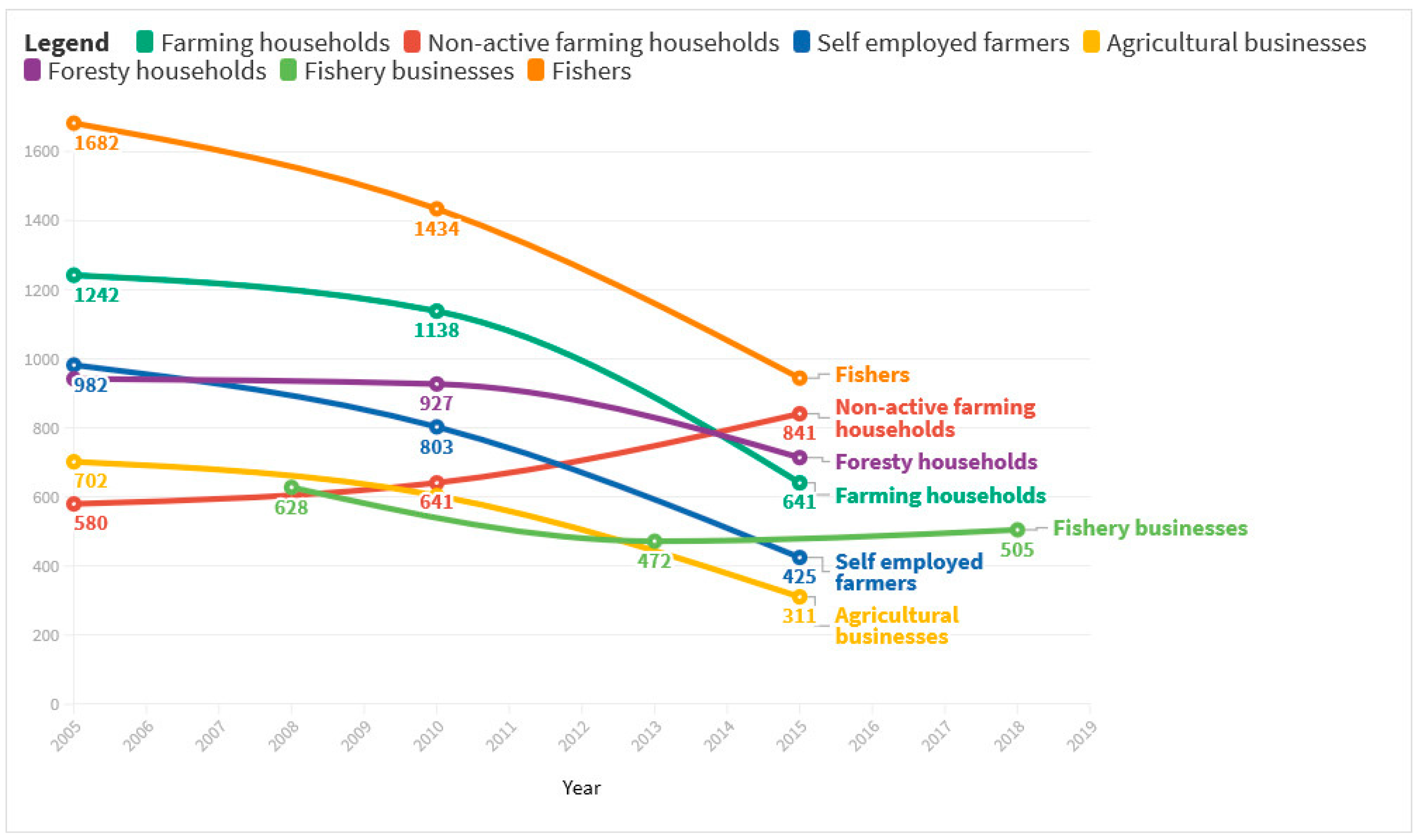
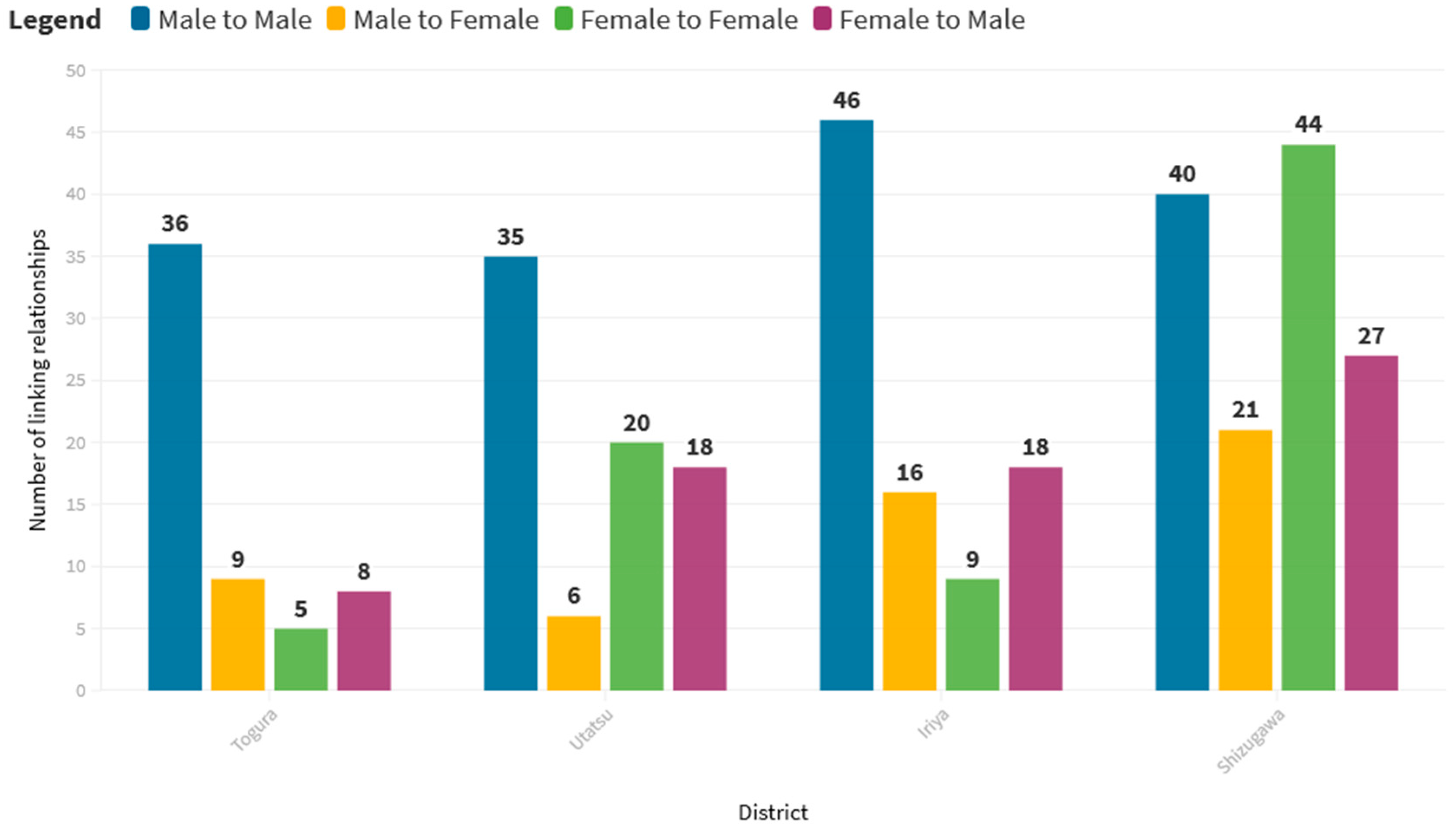
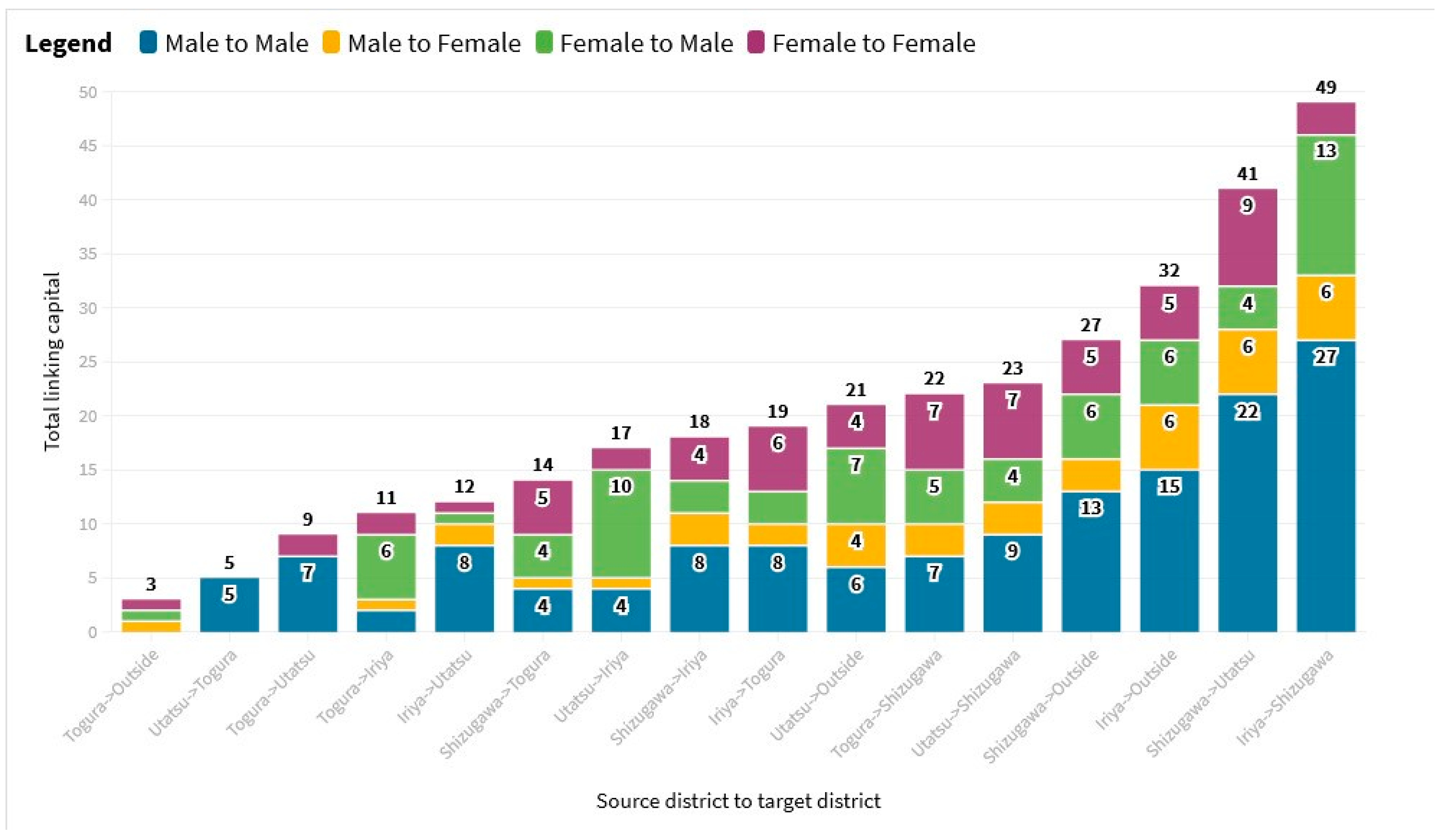
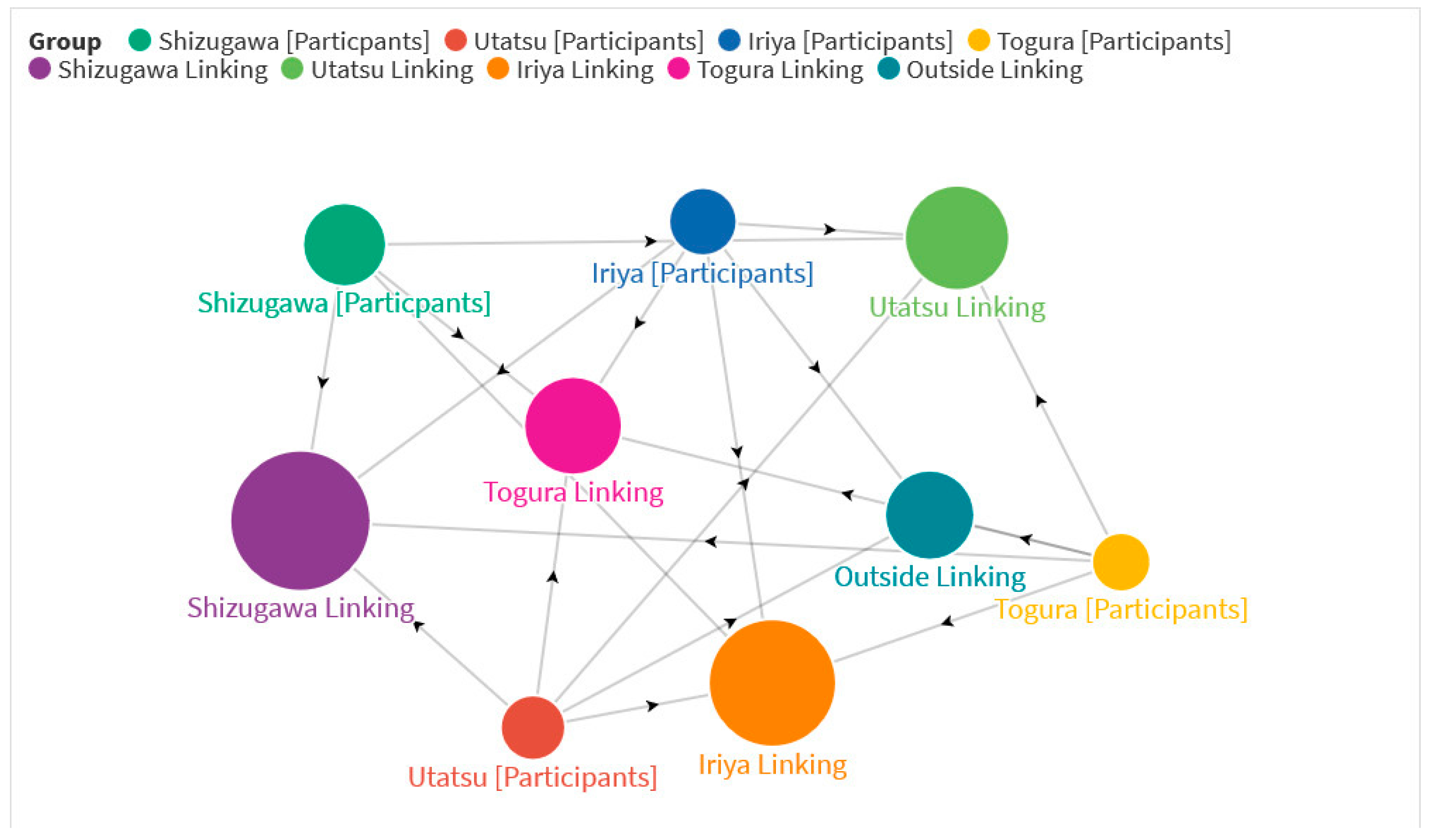
| Descriptive Statistics of Participants (n = 200) | ||||
|---|---|---|---|---|
| Variable | Mean | Standard Deviation | Mode | Range |
| Gender | 0.46 | 0.49 | Female | 0 (female) to 1 (male) |
| District | 1.76 | 1.11 | Shizugawa | 0 (Togura) to 3 (Shizugawa) |
| Age | 42 | 14 | 40 | 20 to 80 |
| Descriptive statistics of relationships (n = 1994) | ||||
| Gender | 0.54 | 0.49 | Male | 0 (female) to 1 (male) |
| District | 2.34 | 1.48 | Shizugawa | 0 (outside) to 4 (Shizugawa) |
| Age | 44 | 15.12 | 40 | 10 to 90 |
| Relationship | 2.82 | 1.63 | Acquaintance | 0 (other) to 5 (family) |
| TieStrength | 0.69 | 0.46 | Strong | 0 (weak) to 1 (strong) |
| SocialCapital | 0.89 | 0.87 | Bonding | 0 (bonding) to 2 (linking) |
| Relation Gender (%) | Relation Ties (%) | Relation Social Capital (%) | ||||||||||||||
|---|---|---|---|---|---|---|---|---|---|---|---|---|---|---|---|---|
| District | Male | Female | Strong | Weak | Bonding | Bridging | Linking | |||||||||
| Shizugawa (n = 724) | 357 (49) | 367 (51) | 494 (68) | 230 (32) | 340 (47) | 152 (21) | 232 (32) | |||||||||
| Utatsu (n = 420) | 228 (54) | 192 (46) | 291 (69) | 129 (31) | 204 (49) | 82 (18) | 134 (33) | |||||||||
| Iriya (n = 508) | 312 (61) | 196 (39) | 370 (73) | 138 (27) | 180 (16) | 127 (25) | 201 (59) | |||||||||
| Togura (n = 342) | 191 (56) | 151 (44) | 226 (66) | 116 (34) | 154 (45) | 85 (25) | 103 (30) | |||||||||
| Relationship (%) | ||||||||||||||||
| Other | Acquaintance | Prev. coworker | Coworker | Friend | Family | |||||||||||
| Shizugawa (n = 724) | 16 (2) | 224 (31) | 26 (4) | 109 (15) | 206 (28) | 143 (20) | ||||||||||
| Utatsu (n = 420) | 13 (3) | 150 (36) | 10 (2) | 64 (15) | 94 (22) | 89 (22) | ||||||||||
| Iriya (n = 508) | 18 (4) | 199 (39) | 25 (5) | 67 (13) | 116 (23) | 83 (16) | ||||||||||
| Togura (n = 342) | 3 (1) | 124 (36) | 16 (5) | 43 (13) | 84 (25) | 72 (20) | ||||||||||
| Relation District (%) | ||||||||||||||||
| Shizugawa | Utatsu | Iriya | Togura | Outside | ||||||||||||
| Shizugawa (n = 724) | 369 (51) | 112 (15) | 69 (10) | 47 (6) | 127 (18) | |||||||||||
| Utatsu (n = 420) | 84 (20) | 203 (48) | 57 (14) | 10 (2) | 66 (16) | |||||||||||
| Iriya (n = 508) | 120 (24) | 33 (6) | 200 (39) | 47 (9) | 108 (22) | |||||||||||
| Togura (n = 342) | 68 (20) | 27 (8) | 35 (10) | 160 (48) | 52 (14) | |||||||||||
Publisher’s Note: MDPI stays neutral with regard to jurisdictional claims in published maps and institutional affiliations. |
© 2021 by the author. Licensee MDPI, Basel, Switzerland. This article is an open access article distributed under the terms and conditions of the Creative Commons Attribution (CC BY) license (https://creativecommons.org/licenses/by/4.0/).
Share and Cite
Ward, K. Effects of Reconstruction Planning on the Utility of Social Capital in Minamisanriku, Miyagi after the 2011 Great East Japan Earthquake. Soc. Sci. 2021, 10, 254. https://doi.org/10.3390/socsci10070254
Ward K. Effects of Reconstruction Planning on the Utility of Social Capital in Minamisanriku, Miyagi after the 2011 Great East Japan Earthquake. Social Sciences. 2021; 10(7):254. https://doi.org/10.3390/socsci10070254
Chicago/Turabian StyleWard, Kayleigh. 2021. "Effects of Reconstruction Planning on the Utility of Social Capital in Minamisanriku, Miyagi after the 2011 Great East Japan Earthquake" Social Sciences 10, no. 7: 254. https://doi.org/10.3390/socsci10070254
APA StyleWard, K. (2021). Effects of Reconstruction Planning on the Utility of Social Capital in Minamisanriku, Miyagi after the 2011 Great East Japan Earthquake. Social Sciences, 10(7), 254. https://doi.org/10.3390/socsci10070254






